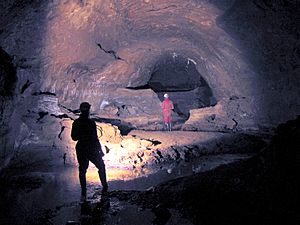Caving in the United Kingdom facts for kids

Caving in the United Kingdom is a fun and exciting hobby! It means exploring natural underground spaces like caves and potholes. People have been exploring caves in the UK since the mid-1800s.
The main places for caving in the UK are North Yorkshire, South Wales, Derbyshire, and the Mendips. There are also smaller caving spots in Devon, North Wales, and Grampian.
Caving became very popular in the 1950s and 60s. Today, about 4,000 people regularly go caving in the UK. Many more people (around 70,000 each year) try caving with an instructor. You can also visit special show caves like Wookey Hole Caves that are open to tourists.
Some cavers even explore underwater passages. This is called cave diving. British cave divers are very skilled. They have helped with cave rescues all over the world.
Contents
History of Caving in the UK
People have always been curious about caves. Long ago, in 1681, a man named John Beaumont wrote detailed notes about some caves in the Mendips. Later, in 1780, John Hutton described caves near Ingleborough. This made more people interested in visiting them.
Early Explorers and Discoveries
In the 1800s, explorers started to go deeper. John Birkbeck explored big holes (called potholes) in Yorkshire. He went into Gaping Gill in 1842 and Alum Pot in 1847-48. Around the same time, Herbert E. Balch began exploring Wookey Hole Caves.
A famous French caver, Édouard-Alfred Martel, visited the UK in the 1890s. He reached an underground lake in Marble Arch Caves in Northern Ireland in 1895. He also explored Gaping Gill, going much deeper than Birkbeck.
Caving Becomes a Sport
By the late 1800s, caving was becoming a sport in the UK. But only a few brave adventurers and scientists did it. The Yorkshire Ramblers' Club was formed in 1892. They started exploring the Marble Arch Caves in 1907. The University of Bristol Spelæological Society began in 1919.
By the 1930s, there were about 30 caving clubs! Eli Simpson started the British Speleological Association (BSA) in 1935. In the same year, the Cave Rescue Organisation was created. It was the first group in the world focused on rescuing people from caves. Jack Sheppard made history in the 1930s. He was the first person to explore underwater caves using special diving gear in Wookey Hole Caves.
Growth After World War II
After World War II, more people got into caving. Bob Leakey found the long Mossdale Caverns in the Yorkshire Dales. In 1946, Graham Balcombe formed the Cave Diving Group. This group focused on exploring water-filled cave passages.
Caving became even more popular in the 1950s and 60s. More clubs were formed, and groups were set up to manage access to caves. The National Association of Caving was created in 1968. In 1977, the UK hosted a big international caving meeting. British cavers shared their amazing discoveries and techniques.
Modern Caving and Discoveries
British cave divers kept pushing boundaries. They explored new areas in Wookey Hole and other caves. New tools and methods in the 1970s and 80s made caving safer and allowed for harder explorations. In 1979, a TV show called The Underground Eiger showed a world-record cave dive. Geoff Yeadon and Oliver Statham dived 1,800 meters (6,000 feet) underwater!
Because British cavers have explored so much, most new discoveries now happen after a lot of hard work. Cavers often spend months or years digging through passages. Some cool recent finds include Titan, the biggest underground shaft in Britain. Also, Ogof Draenen is now the second longest cave in Britain. In 2010-11, cavers finally connected different parts of the Three Counties System. This made it the longest cave system in the UK!
Where to Go Caving
The UK has many great places to go caving.
Main Caving Areas
The four main areas for caving are:
Smaller caving areas include Devon, North Wales, and Grampian.
Show Caves for Visitors
If you want to see a cave without all the gear, you can visit a show cave. These caves are set up for tourists with paths and lights. Some popular show caves are:
- Wookey Hole Caves in the Mendips
- Dan-yr-Ogof in South Wales
- Peak Cavern in the Peak District
- Ingleborough Cave in the Yorkshire Dales
- Marble Arch Caves in County Fermanagh
Caving Clubs and Groups
There are many groups that help cavers. The British Caving Association is the main group for caving in the UK. There are also regional groups like the Cambrian Caving Council. Many local caving clubs exist too. These clubs often go on trips to explore caves in other countries.
Cave Rescue in the UK
Sometimes, cavers can get into trouble underground. That's where cave rescue teams come in!
British Cave Rescue Council (BCRC)
| Founded | 1967 |
|---|---|
| Type | Registered Charity |
|
Region served
|
British Isles |
| Services | Cave Rescue |
| Peter Dennis | |
|
Key people
|
Bill Whitehouse MBE |
The British Cave Rescue Council (BCRC) was started in 1967. It helps to coordinate 15 different cave rescue groups across the British Isles. These groups include the Cave Rescue Organisation and the Irish Cave Rescue Organisation.
About 1,000 volunteer rescuers are ready to help. They have special equipment and training to rescue people from caves and old mines. These volunteers are all experienced cavers. Many also have special skills like first aid or cave diving.
British cave divers are famous for their rescue skills. People like Richard Stanton, John Volanthen, Jason Mallison, and Chris Jewell have helped with rescues all over the world. They were part of the amazing rescue of a football team from the Tham Luang cave rescue in Thailand in 2018. They also helped in Mexico in 2004, France in 2010, Ireland in 2011, and Norway in 2006 and 2014.

